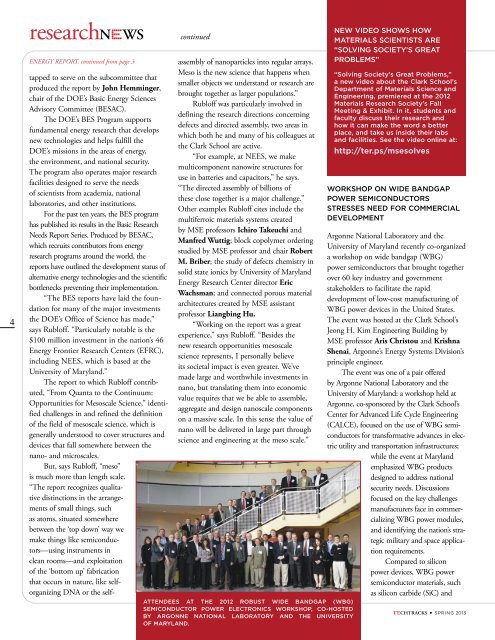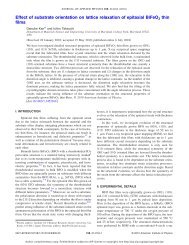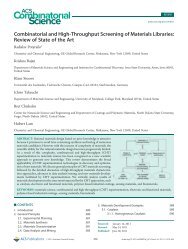Spring 2013 - Materials Science and Engineering - University of ...
Spring 2013 - Materials Science and Engineering - University of ...
Spring 2013 - Materials Science and Engineering - University of ...
- No tags were found...
You also want an ePaper? Increase the reach of your titles
YUMPU automatically turns print PDFs into web optimized ePapers that Google loves.
4researchNEWSENERGY REPORT, continued from page 3continuedtapped to serve on the subcommittee thatproduced the report by John Hemminger,chair <strong>of</strong> the DOE’s Basic Energy <strong>Science</strong>sAdvisory Committee (BESAC).The DOE’s BES Program supportsfundamental energy research that developsnew technologies <strong>and</strong> helps fulfill theDOE’s missions in the areas <strong>of</strong> energy,the environment, <strong>and</strong> national security.The program also operates major researchfacilities designed to serve the needs<strong>of</strong> scientists from academia, nationallaboratories, <strong>and</strong> other institutions.For the past ten years, the BES programhas published its results in the Basic ResearchNeeds Report Series. Produced by BESAC,which recruits contributors from energyresearch programs around the world, thereports have outlined the development status <strong>of</strong>alternative energy technologies <strong>and</strong> the scientificbottlenecks preventing their implementation.“The BES reports have laid the foundationfor many <strong>of</strong> the major investmentsthe DOE’s Office <strong>of</strong> <strong>Science</strong> has made,”says Rubl<strong>of</strong>f. “Particularly notable is the$100 million investment in the nation’s 46Energy Frontier Research Centers (EFRC),including NEES, which is based at the<strong>University</strong> <strong>of</strong> Maryl<strong>and</strong>.”The report to which Rubl<strong>of</strong>f contributed,“From Quanta to the Continuum:Opportunities for Mesoscale <strong>Science</strong>,” identifiedchallenges in <strong>and</strong> refined the definition<strong>of</strong> the field <strong>of</strong> mesoscale science, which isgenerally understood to cover structures <strong>and</strong>devices that fall somewhere between thenano- <strong>and</strong> microscales.But, says Rubl<strong>of</strong>f, “meso”is much more than length scale.“The report recognizes qualitativedistinctions in the arrangements<strong>of</strong> small things, suchas atoms, situated somewherebetween the ‘top down’ way wemake things like semiconductors—usinginstruments inclean rooms—<strong>and</strong> exploitation<strong>of</strong> the ‘bottom up’ fabricationthat occurs in nature, like selforganizingDNA or the selfassembly<strong>of</strong> nanoparticles into regular arrays.Meso is the new science that happens whensmaller objects we underst<strong>and</strong> or research arebrought together as larger populations.”Rubl<strong>of</strong>f was particularly involved indefining the research directions concerningdefects <strong>and</strong> directed assembly, two areas inwhich both he <strong>and</strong> many <strong>of</strong> his colleagues atthe Clark School are active.“For example, at NEES, we makemulticomponent nanowire structures foruse in batteries <strong>and</strong> capacitors,” he says.“The directed assembly <strong>of</strong> billions <strong>of</strong>these close together is a major challenge.”Other examples Rubl<strong>of</strong>f cites include themultiferroic materials systems createdby MSE pr<strong>of</strong>essors Ichiro Takeuchi <strong>and</strong>Manfred Wuttig; block copolymer orderingstudied by MSE pr<strong>of</strong>essor <strong>and</strong> chair RobertM. Briber; the study <strong>of</strong> defects chemistry insolid state ionics by <strong>University</strong> <strong>of</strong> Maryl<strong>and</strong>Energy Research Center director EricWachsman; <strong>and</strong> connected porous materialarchitectures created by MSE assistantpr<strong>of</strong>essor Liangbing Hu.“Working on the report was a greatexperience,” says Rubl<strong>of</strong>f. “Besides thenew research opportunities mesoscalescience represents, I personally believeits societal impact is even greater. We’vemade large <strong>and</strong> worthwhile investments innano, but translating them into economicvalue requires that we be able to assemble,aggregate <strong>and</strong> design nanoscale componentson a massive scale. In this sense the value <strong>of</strong>nano will be delivered in large part throughscience <strong>and</strong> engineering at the meso scale.”Attendees at the 2012 Robust Wide B<strong>and</strong>gap (WBG)Semiconductor Power Electronics Workshop, co-hostedby Argonne National Laboratory <strong>and</strong> the <strong>University</strong><strong>of</strong> Maryl<strong>and</strong>.New Video Shows How<strong>Materials</strong> Scientists Are“Solving Society’s GreatProblems”“Solving Society’s Great Problems,”a new video about the Clark School’sDepartment <strong>of</strong> <strong>Materials</strong> <strong>Science</strong> <strong>and</strong><strong>Engineering</strong>, premiered at the 2012<strong>Materials</strong> Research Society’s FallMeeting & Exhibit. In it, students <strong>and</strong>faculty discuss their research <strong>and</strong>how it can make the word a betterplace, <strong>and</strong> take us inside their labs<strong>and</strong> facilities. See the video online at:http://ter.ps/msesolvesWorkshop on Wide B<strong>and</strong>gapPower SemiconductorsStresses Need for CommercialDevelopmentArgonne National Laboratory <strong>and</strong> the<strong>University</strong> <strong>of</strong> Maryl<strong>and</strong> recently co-organizeda workshop on wide b<strong>and</strong>gap (WBG)power semiconductors that brought togetherover 60 key industry <strong>and</strong> governmentstakeholders to facilitate the rapiddevelopment <strong>of</strong> low-cost manufacturing <strong>of</strong>WBG power devices in the United States.The event was hosted at the Clark School’sJeong H. Kim <strong>Engineering</strong> Building byMSE pr<strong>of</strong>essor Aris Christou <strong>and</strong> KrishnaShenai, Argonne’s Energy Systems Division’sprinciple engineer.The event was one <strong>of</strong> a pair <strong>of</strong>feredby Argonne National Laboratory <strong>and</strong> the<strong>University</strong> <strong>of</strong> Maryl<strong>and</strong>: a workshop held atArgonne, co-sponsored by the Clark School’sCenter for Advanced Life Cycle <strong>Engineering</strong>(CALCE), focused on the use <strong>of</strong> WBG semiconductorsfor transformative advances in electricutility <strong>and</strong> transportation infrastructures;while the event at Maryl<strong>and</strong>emphasized WBG productsdesigned to address nationalsecurity needs. Discussionsfocused on the key challengesmanufacturers face in commercializingWBG power modules,<strong>and</strong> identifying the nation’s strategicmilitary <strong>and</strong> space applicationrequirements.Compared to siliconpower devices, WBG powersemiconductor materials, suchas silicon carbide (SiC) <strong>and</strong>TECHTRACKS SPRING <strong>2013</strong>












